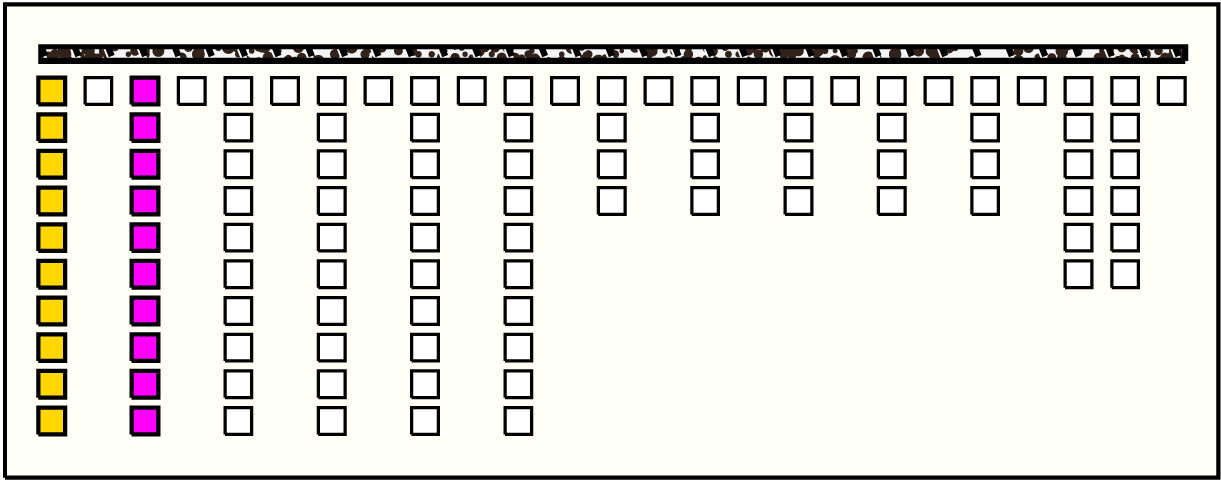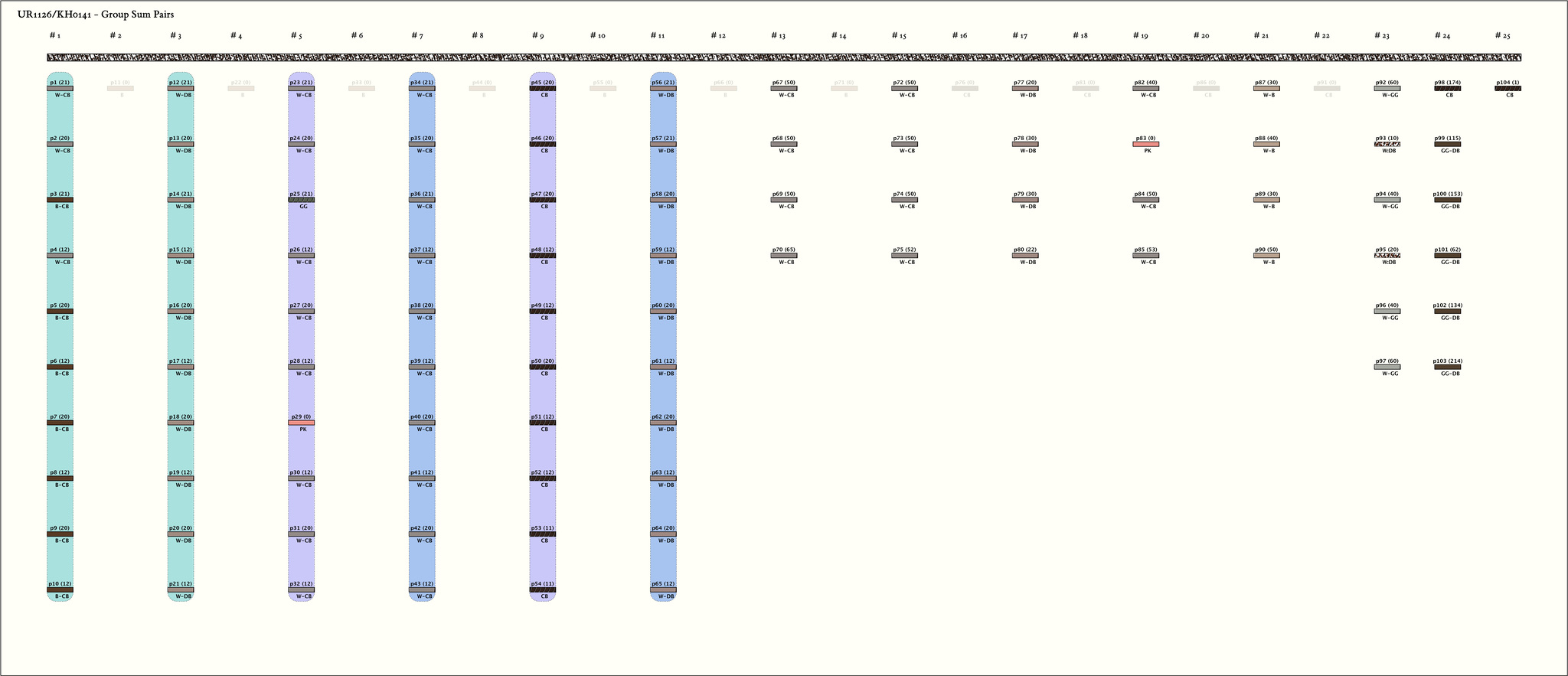UR1126/KH0141 - Group Group Sums
Drawings:
Group-Group Sum:
Click on Image to View Larger
Individual Group Group Sums: - Click on column name to sort
| # | Group Group Sum Schema | Group Sum Value | Is Top Group | Is Duplicate Group | Group Position Difference | Left Group Position (1_based index) |
Right Group Position (1_based index) |
Left Sum (1_based index) |
Right Sum (1_based index) |
|---|---|---|---|---|---|---|---|---|---|
| 1 |  | 170 | False | False | 2 | 1 | 3 | W-CB@[0, 0]:21 + CB@[0, 0, 0]:1 + W-CB@[0, 1]:20 + W@[0, 1, 0]:1 + B-CB@[0, 2]:21 + W@[0, 2, 0]:1 + W-CB@[0, 3]:12 + B@[0, 3, 0]:0 + B-CB@[0, 4]:20 + W@[0, 4, 0]:0 + B-CB@[0, 5]:12 + W@[0, 5, 0]:0 + B-CB@[0, 6]:20 + B@[0, 6, 0]:0 + B-CB@[0, 7]:12 + W@[0, 7, 0]:1 + B@[0, 7, 1]:0 + B-CB@[0, 8]:20 + B@[0, 8, 0]:0 + B-CB@[0, 9]:12 + W@[0, 9, 0]:0 | W-DB@[2, 0]:21 + W-DB@[2, 1]:20 + W-DB@[2, 2]:21 + W-DB@[2, 3]:12 + W-DB@[2, 4]:20 + W-DB@[2, 5]:12 + W-DB@[2, 6]:20 + W-DB@[2, 7]:12 + W-DB@[2, 8]:20 + W-DB@[2, 9]:12 |
| 2 |  | 150 | False | False | 4 | 5 | 9 | W-CB@[4, 0]:21 + W-CB@[4, 1]:20 + GG@[4, 2]:21 + W-CB@[4, 3]:12 + W-CB@[4, 4]:20 + W-CB@[4, 5]:12 + PK@[4, 6]:0 + W-CB@[4, 7]:12 + W-CB@[4, 8]:20 + W-CB@[4, 9]:12 | CB@[8, 0]:20 + CB@[8, 1]:20 + CB@[8, 2]:20 + CB@[8, 3]:12 + CB@[8, 4]:12 + CB@[8, 5]:20 + CB@[8, 6]:12 + CB@[8, 7]:12 + CB@[8, 8]:11 + CB@[8, 9]:11 |
| 3 |  | 170 | False | False | 4 | 7 | 11 | W-CB@[6, 0]:21 + W-CB@[6, 1]:20 + W-CB@[6, 2]:21 + W-CB@[6, 3]:12 + W-CB@[6, 4]:20 + W-CB@[6, 5]:12 + W-CB@[6, 6]:20 + W-CB@[6, 7]:12 + W-CB@[6, 8]:20 + W-CB@[6, 9]:12 | W-DB@[10, 0]:21 + W-DB@[10, 1]:21 + W-DB@[10, 2]:20 + W-DB@[10, 3]:12 + W-DB@[10, 4]:20 + W-DB@[10, 5]:12 + W-DB@[10, 6]:20 + W-DB@[10, 7]:12 + W-DB@[10, 8]:20 + W-DB@[10, 9]:12 |
Khipu Notes:
Ascher Databook Notes:
- This is one of several khipus acquired by the Museum in 1907 with provance Ica. For a list of them, see UR1100.
- By spacing, the khipu is separated into 3 parts. By spaces smaller than that between the parts and by markers, part 1 is separated into 6 groups of 10 pendants each, and part 2 is 6 groups of 4 pendants each (with 2 additional pendants in the last group). Part 3 is 1 group of 6 pendants.
- Each group is unified by color. In part 1: group 1 is CB-W or CB-B; groups 2 and 6 are DB-W; groups 3 and 4 are CB-W; and group 5 is CB. The markers between them are short B cords. In part 2: groups 1, 2, and 4 are CB-W; group 3 is DB-W; and group 5 is B-W. In group 6, 4 of the pendants are GG-W and 2 additional pendants (1 between positions 1 and 2, and the other between positions 2 and 3) are DB:W. In part 3, with the exception of the first pendant, the group is DB-GG.
- In part 1 (assuming that the missing P27 had value 20):
- The only pendant values are 11, 12, 20, and 21 and the subsidiary values are 0 or 1.
- The 60 pendant values sum to 1000.
- All the values in corresponding positions are the same for groups 1, 2, 3, and 4. With the exception of the interchange of values in positions 2 and 3, the values in group 6 are also the same.
- In part 2 (assuming that the missing P74 had value 40):
- The only pendant values in positions 1-3 of all groups are 20, 30, 40, 50, 60.
- The sum of the values in each of the first 3 positions in the 6 groups is 250.
That is:
\[ \sum\limits_{i=1}^6 P_{i1}=\sum\limits_{i=1}^6 P_{i2}=\sum\limits_{i=1}^6 P_{i3}= 250 \]
